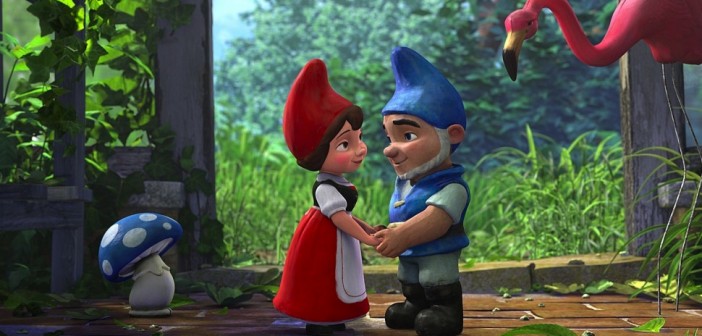In what might become an anthem for the Gnome Liberation Front, Gnomeo & Juliet (very loosely) retells the story of William Shakespeare’s famed tragedy of nearly the same name. But, after all, a movie about doomed garden gnome love by any other name is still as dreadful. Oddly enough, a pastiche of Shakespeare puns and gardening jokes took nine writers – Andy Riley, Kevin Cecil, Mark Burton, Emily Cook, Kathy Greenberg, Steve Hamilton Shaw, Kelly Asbury, Rob Sprackling, and John R. Smith – to fully realize. That might be the funniest thing about the film. Between them, be it final touch-ups, penning the original stories, script drafts, or tossing in jokes here and there, they pulled off true movie magic: a film that feels like it has no screenplay at all, written by a small committee.
Most of us grew up knowing the story of Romeo and Juliet, and for the little kids who are for some reason seeing this film, a small gnome sets our scene: “Two gardens, both alike in dignity, in fair grass, where we lay our scene, from ancient grudge break to new mutiny, where civil dirt makes civil ceramic unclean. From forth the fatal loins of these two foes a pair of star-cross’d gnomes pull through it all right; whose misadventured piteous overthrows do with their lame puns bury their parents’ strife. The fearful passage of their scuff-mark’d love, and the continuance of their parents’ rage, which, but their children’s end, nought could remove, is now the 86 minutes’ traffic of our stage; the which if you with patient ears attend, what here shall miss, our toil shall strive to mend.” And if you’ll buy that, I have a bridge I need to get off my hands. Baz Lurhmann’s take, 1996′s Romeo + Juliet, was rooted in gang violence in Southern California. That feud was believable. All other versions, we’re committed to going along with simply because they’re direct adaptations of the play. Here, we’re expected to believe several key things without batting an eye.
There are still two houses: Montague and Capulet. They are townhouses, with beautiful backyards populated with creepy doe-eyed figurines, fake animals, and for some reason, one of them has a toilet while the other one has a giant mechanical castle.We’re expected to believe that the garden gnomes are feuding because these two neighbors hate each other. The gnomes come alive when no one is looking (Toy Story, much?) and freeze in their normal positions when people come back around (… Toy Story, much.) The equivalent of a death in the gnome world would be being shattered or broken, but, as the film proves against its own logic, if you can glue something back together in the end and make everything okay, why worry about a character dying in the first place? And there you have it, folks – in a film loosely based on a play about two kids dying, whoever gets hurt can be glued back together. All dramatic tensions thereby completely vanished, and we have another hour to figure out what we’re doing after the movie.
To compare this to its betters, be it the Toy Story franchise, or the Shrek series (the second film, specifically, which Gnomeo co-writer/director Kelly Asbury handled), or say this year’s Rio, for instance, it pales. The Toy Story films wind up being emotional, hysterical, and mature enough for all audiences. Rio, pure cutesy kitsch. Shrek? Gross, off-putting, but wildly entertaining. Gnomeo & Juliet zaps all of the fun out of Shakespeare by making it inaccessible to even the most educated of people. Set against the backdrop of Elton John music (for some unknown reason), the film asks its audience to shut off its brain (and nerve endings, and heart, and all other organs) and lie dead in a seat for an hour and a half while it makes the kids ask what the hell a garden gnome is in the first place. I’d feel better giving my child a copy of the play and reading it with them, educating them and entertaining them, spending quality time together – the type of things movies like this inadvertently get in the way of. There’s no reason this should be tied to the Bard’s name.
The film winds up running out of steam, and gimmicks, after the first half-hour or so. We can pick out pieces of Elton John songs in the score, we can recognize the voices of astonishing actors who just happened to be either broke or free for a weekend, we can count the jokes or references to other Shakespeare plays, or we can wonder why there isn’t even a Mercutio figure in the whole lot. We can wonder why the film had to be in 3D (probably to trump up the worldwide gross) if it was mainly just used for about five or ten minutes, most of which didn’t require 3D at all, just better animation. It all boils down to this: it’s a film about garden gnomes, based on Romeo and Juliet, with Elton John music. That is literally the depth of Gnomeo & Juliet. Gimmick, pun, head-scratching ending – shallow. Perhaps the greatest tragedy in this story is that it made a decent amount of money. Also, the fact that the talents of James McAvoy, Michael Caine, Emily Blunt, and dozens of other actors went so fervently along with such an inane idea.

